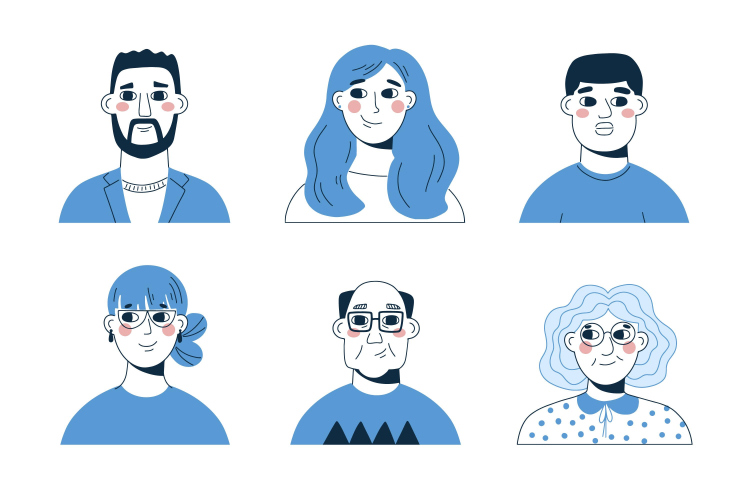
Understanding User Personas in UX/UI Design
Ever wondered why some digital experiences feel so smooth and engaging while others feel disjointed and frustrating? Well, much of it boils down to how well the design team understood their user base. At the heart of this understanding lies the concept of User Personas in UX/UI Design. Intriguing, isn’t it? These fictional but data-driven models of your users are a cornerstone of UX/UI Design. Understanding them can make the difference between a product that solves a problem and a product that falls flat. We are about to delve into the intricate universe of user personas and how they shape the customer journey in UX/UI design. Let's unravel this mystery together.
The Concept of User Personas in UX/UI Design
The magic of UX/UI Design is in its ability to resonate with users on a deeply personal level, and to achieve this, you need to know your users like the back of your hand. Here's where User Personas step in. These are semi-fictional representations of your actual users, created based on comprehensive user research and real data. Understanding the role and importance of User Personas in UX/UI Design is like understanding the blueprint of a building. It helps you grasp the essence of user expectations, preferences, and behaviors, leading to a more meaningful and personalized customer journey.
The Process of Persona Creation
Crafting User Personas is an exercise of intuition backed by concrete data. A compelling persona isn’t born out of creative fiction, but rather through a rigorous step-by-step process that demands deep research, careful observation, and thoughtful synthesis of information.
The Step-by-Step Process of Creating User Personas
The persona creation journey commences with data collection, a critical stage where you gather as much information as possible about your potential users. This could involve conducting user surveys or interviews, diving into usage statistics, and sometimes, good old-fashioned field research to observe users in their natural habitat. The objective is to capture a holistic picture of your users - their behaviors, attitudes, goals, needs, pain points, and preferences.
Once armed with this data, the next step is data analysis. Here, you delve into the collated data, looking for commonalities, patterns, and unique insights. The goal is to identify distinct groups within your user base, each defined by shared characteristics and behaviors.
These shared traits form the foundation for the next step - the actual creation of user personas. Based on your analysis, you craft detailed, individual personas that encapsulate the key traits and behaviors of each user group. Each persona is given a name, a story, motivations, and even a face, making them relatable and human-like.
Tools and Techniques Used in Persona Creation
The process of persona creation isn't a solitary endeavor; it's backed by various tools and techniques designed to facilitate the process. For data collection, tools like online surveys (SurveyMonkey), interviews, or user testing platforms (like UserTesting) can provide invaluable user insights. In the analysis phase, affinity diagramming can help identify patterns and commonalities in the collected data. When it comes to crafting the personas, specialized software like Xtensio, or even simple design tools like Adobe Photoshop or Sketch, can be used to give life to your personas.
Case Study: Persona Creation in Action
Let's look at an example to better understand the process. Suppose we're creating a fitness app designed for busy professionals. Our initial user research, consisting of surveys and interviews, reveals a trend: many users find it hard to fit regular exercise into their packed schedules and struggle with maintaining consistent workout routines.
Our data analysis confirms this pattern, along with other common traits like an interest in quick, effective workouts, the importance of tracking progress, and a desire for nutritional guidance.
From this data, we create our persona: 'Busy Brenda.' Brenda is a 30-year-old marketing professional juggling her demanding job and personal life. She values her health but struggles to fit consistent workouts into her schedule. Brenda is seeking a solution that offers quick, effective workouts, enables her to track her progress, and provides nutritional tips.
With 'Busy Brenda' in mind, the design process for the fitness app becomes more focused. The UX/UI design can be tailored to Brenda's needs and goals, making the app more relevant and useful for users like her.

Understanding User Goals and Needs
User goals and needs form the guiding light of your design journey. The goals represent what the users aim to achieve with your product – it could be something straightforward like booking a ticket, or something abstract like feeling empowered. Identifying these goals gives your design a purpose. Meanwhile, user needs are conditions that must be met for the user to feel satisfied. Understanding these needs means creating a design that not only fulfills its function but does so in a way that users find intuitive and enjoyable. When you create a perfect blend of user goals and needs in your design, you've hit the UX/UI sweet spot.
The Role of User Behavior in Persona Development
User behavior is the compass that directs the course of persona development. It is a thorough understanding of how users interact with your product, their actions, preferences, and decision-making processes. Are they impulsive or deliberate? Do they value aesthetics over functionality or vice versa? Observing these behaviors offers rich insights, enabling you to craft user personas that accurately mirror your user base. These personas then guide your design decisions, ensuring your product aligns with user behavior.
User Characteristics that Define Personas
Understanding a user persona requires a deep dive into a broad spectrum of user characteristics. These include demographic details like age and occupation, psychological traits such as preferences and motivations, and even their level of tech-savviness. Remember 'Busy Brenda'? Brenda's character extends beyond being a marketing professional. She could be juggling her career with personal responsibilities, trying to squeeze health and fitness into her packed schedule, or she might be someone who values tracking progress and desires nutritional guidance. These characteristics allow designers to empathize better with users, resulting in a design that's genuinely user-centric.

Empathy Mapping in UX/UI Design
Creating user personas is just one half of the story. Truly understanding them requires empathy – the ability to put yourself in their shoes. Empathy Mapping in UX/UI Design is an essential technique that helps you visualize what the user is seeing, thinking, feeling, and doing. It's like viewing the world through their lens. This deeper understanding allows you to design experiences that users find instinctively engaging and satisfying.
Identifying and Understanding the Target Audience
To design a product that truly resonates with users, you must first identify your target audience. This is the group of people who will most likely use and benefit from your product. User personas, with their rich tapestry of details, are the compass that leads you to your target audience. They help you understand not just who your audience is, but also their desires, frustrations, motivations, and behaviors. By understanding your target audience on this granular level, you can create products that they connect with and appreciate.
Conclusion
And just like that, we've navigated the fascinating landscape of user personas in UX/UI design. We've unraveled their significance, the process of their creation, and their influence on crafting empathetic, user-centric designs. With user personas as your guide, you can illuminate the path to creating products that users love and value. So, why not give it a go in your next design project?
References
Eager to learn more about user personas in UX/UI design? Here are some resources that could help enhance your understanding:
- Cooper, A., Reimann, R., Cronin, D., & Noessel, C. (2014). About Face: The Essentials of Interaction Design. Wiley.
- Mulder, S., & Yaar, Z. (2006). The User Is Always Right: A Practical Guide to Creating and Using Personas for the Web. New Riders.
 Mark Petrenko
Mark Petrenko 
